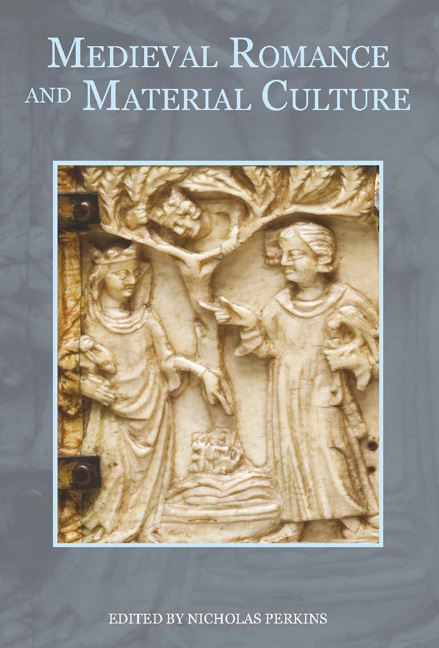Book contents
- Frontmatter
- Contents
- List of Illustrations
- List of Contributors
- Acknowledgements
- Abbreviations
- 1 Introduction: The Materiality of Medieval Romance and The Erle of Tolous
- 2 Courtly Culture and Emotional Intelligence in the Romance of Horn
- 3 Emplaced Reading, or Towards a Spatial Hermeneutic for Medieval Romance
- 4 Devotional Objects, Saracen Spaces and Miracles in Two Matter of France Romances
- 5 The Werewolf of Wicklow: Shapeshifting and Colonial Identity in the Lai de Melion
- 6 ‘Ladyes war at thare avowing’: The Female Gaze in Late-Medieval Scottish Romance
- 7 The Evolution of Cooperation in The Avowyng of Arthur
- 8 Ritual, Revenge and the Politics of Chess in Medieval Romance
- 9 Adventures in the Bob-and-Wheel Tradition: Narratives and Manuscripts
- 10 Reading King Robert of Sicily's Text(s) and Manuscript Context(s)
- 11 The Circulation of Romances from England in Late-Medieval Ireland
- 12 The Image of the Knightly Harper: Symbolism and Resonance
- 13 Carving the Folie Tristan: Ivory Caskets as Material Evidence of Textual History
- 14 Romancing the Orient: The Roman d'Alexandre and Marco Polo's Livre du grand Khan in Oxford, Bodleian Library MS Bodl. 264
- 15 The Victorian Afterlife of The Thornton Romances
- Index
11 - The Circulation of Romances from England in Late-Medieval Ireland
Published online by Cambridge University Press: 05 May 2015
- Frontmatter
- Contents
- List of Illustrations
- List of Contributors
- Acknowledgements
- Abbreviations
- 1 Introduction: The Materiality of Medieval Romance and The Erle of Tolous
- 2 Courtly Culture and Emotional Intelligence in the Romance of Horn
- 3 Emplaced Reading, or Towards a Spatial Hermeneutic for Medieval Romance
- 4 Devotional Objects, Saracen Spaces and Miracles in Two Matter of France Romances
- 5 The Werewolf of Wicklow: Shapeshifting and Colonial Identity in the Lai de Melion
- 6 ‘Ladyes war at thare avowing’: The Female Gaze in Late-Medieval Scottish Romance
- 7 The Evolution of Cooperation in The Avowyng of Arthur
- 8 Ritual, Revenge and the Politics of Chess in Medieval Romance
- 9 Adventures in the Bob-and-Wheel Tradition: Narratives and Manuscripts
- 10 Reading King Robert of Sicily's Text(s) and Manuscript Context(s)
- 11 The Circulation of Romances from England in Late-Medieval Ireland
- 12 The Image of the Knightly Harper: Symbolism and Resonance
- 13 Carving the Folie Tristan: Ivory Caskets as Material Evidence of Textual History
- 14 Romancing the Orient: The Roman d'Alexandre and Marco Polo's Livre du grand Khan in Oxford, Bodleian Library MS Bodl. 264
- 15 The Victorian Afterlife of The Thornton Romances
- Index
Summary
The fifteenth century saw a striking upturn in the number of texts from foreign vernaculars that were translated into Irish. Indeed, one might go so far as to speak in terms of a ‘translation trend’ in Ireland during the mid- to late fifteenth century. A notable feature of this trend is that a particularly high number of these Irish translations are of romances; contextual and textual evidence suggests that the original exemplars for many of these translated texts appear to have come from England, though not all of them were necessarily in English. Irish translations of eight romances have survived to the present day: Guy of Warwick; Bevis of Hampton; La Queste de Saint Graal; Fierabras; Caxton's Recuyell of the Histories of Troie; William of Palerne; the Seven Sages of Rome; and Octavian. The last three all survive in manuscripts of the seventeenth century, but the Seven Sages and William almost certainly go back to the fifteenth or early sixteenth century respectively, while Octavian, though its scholarly neglect has been rather more total than that of the other texts, seems likely to date from the same period. Two of these texts, Fierabras and the Seven Sages of Rome, also survive in late-medieval Latin versions in an Irish manuscript. This copy of Fierabras represents the only known version of that narrative in Latin and appears in turn to have been translated from the French chanson de geste.
The translation of texts from foreign vernaculars in late-medieval Ireland has received little in the way of concerted scholarly examination. The most complete overviews of the fifteenth-century translations still remain the short preliminary accounts by Robin Flower and James Carney. These Irish adaptations have a pronounced tendency to fall into the cracks between disciplines: they have often been overlooked by Celticists because they are not part of the ‘native’ corpus and they also remain untapped by medievalists in other areas, presumably because they are not clearly part of their own fields and, perhaps, because of the forbidding linguistic barrier of medieval Irish.
- Type
- Chapter
- Information
- Medieval Romance and Material Culture , pp. 183 - 198Publisher: Boydell & BrewerPrint publication year: 2015

